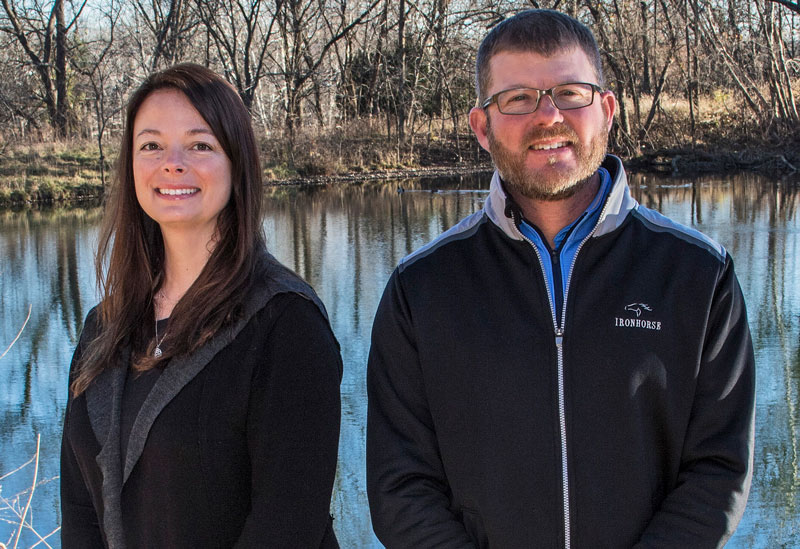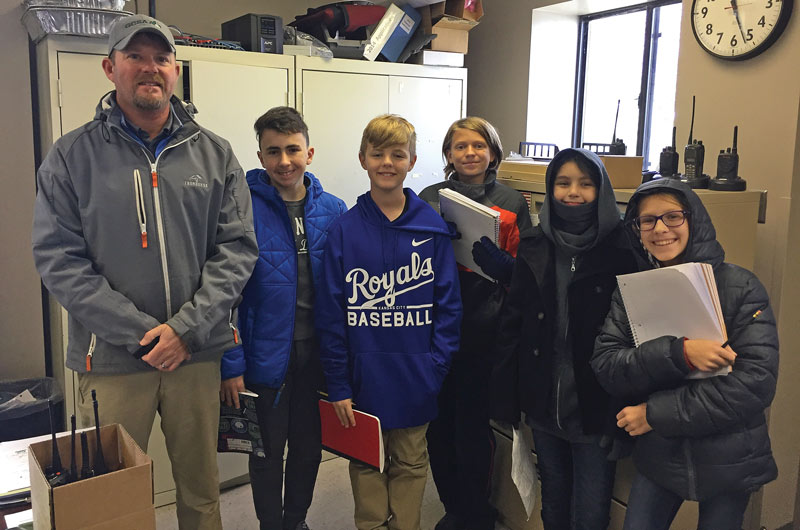
TJ Seaberg (left), a coach with FIRST Lego League — an international education program that engages elementary and middle school students in real-world science and technology challenges — with GCSAA Class A superintendent James Kennedy at Ironhorse Golf Club in Leawood, Kan. Photo by Andy Lundberg
The leaders of tomorrow had the future on their minds when they paid a recent visit to GCSAA Class A superintendent James Kennedy.
They ranged in age from 11 to 14, seven boys and girls, armed with eager intentions and inquisitive minds. Led by their co-coaches, TJ Seaberg and Heidi Mann, these middle school students came to Ironhorse Golf Club in Leawood, Kan., as participants in FIRST Lego League (FLL). They arrived with an objective: Determine ways golf courses can conserve water.
“We need to find how to decrease water use. It’s not just golf courses that need to find ways to do that. There are so many other problems with water. We researched it,” says 14-year-old Manasvi Chennareddy, a student at Lakewood Middle School in Overland Park, Kan.
Kennedy, Seaberg and Mann are key figures in this endeavor. A 19-year member of GCSAA, Kennedy provided the living laboratory to help participants learn what they needed to know about golf courses and how they use and conserve water. Seaberg, who is in her fifth year as an FLL coach, and Mann, in her second year, guide the team. FLL is a non-sponsored school event, so it takes professionals such as Kennedy and volunteers such as Seaberg and Mann to step up and oversee this type of program.
If you’re unfamiliar with FLL, so was Kennedy. Before the participants arrived at Ironhorse, he went online and learned that FLL is a program that allows students to research and develop solutions to real-world problems in areas such as energy, recycling, etc., all while competing with other teams in regional, national and worldwide events.
“I did Science Olympiad when I was younger, but not anything like this,” Kennedy says. “I was thoroughly impressed with these kids, how prepared they were. They asked a lot of questions.”
The project for the Seaberg-Mann team — named H2OVERDRIVE — was to find ways for golf courses to be more cost-efficient and conservative in their water use. H2OVERDRIVE’s solution was to use rain barrels with a mesh netting on top (to prevent debris from contaminating the water) and to strategically place them to collect water in areas of the golf course that receive more rain/irrigation than is necessary. The barrels, fitted with pipes, funnel water to the irrigation system, from which it can then be used to irrigate the golf course.
Their plan perfectly fits the FLL model, which focuses on real-world challenges and solutions. FLL encourages teamwork, critical thinking, and the concept that discovering is more important than winning. “FIRST Lego League challenges kids to think like scientists and engineers, and that’s exactly what they did here,” says Gretchen Neis, an FLL partner at KC STEM Alliance, which is a collaborative network of educators, business partners and affiliates inspiring interest in science, technology, engineering and math (STEM) careers. “They looked at all types of water usage before zeroing in on ways to help reduce overall water use by golf courses. Then they brainstormed ideas, researched options, and checked their proposed idea with industry pros before finalizing their solution.”

Ironhorse Golf Club GCSAA Class A superintendent James Kennedy welcomed a group of middle school students looking to learn about golf course water conservation. Pictured (left to right) are Kennedy, Nathan Binshtok, Mason Seaberg, Liam Mann, Madeline Lingenfelser and Elena Mann. Photo courtesy of Heidi Mann
Seaberg’s children have been active in FLL for many years. Her oldest son, Sajon, was on a team that advanced to the FLL World Festival and FLL North American Open at Legoland California Resort, and now he’s paying it forward as an FLL youth mentor. No wonder, then, that his mother is rightly proud of both her children’s and her team’s efforts. “They learn how to be responsible, accountable, and learn how to apply those things in their everyday lives. They learn it’s OK to fail and keep trying again,” she says.
Thirteen-year-old Nathan Binshtok loves the process. “It has helped me grow as a person, learn how to be innovative, and be a good team member,” he says.
Mann has two children, Elena and Liam, in FLL. She has seen what the experience has done for them. “They are more thoughtful and understanding of how their actions affect other people,” Mann says.
On the Ironhorse expedition, Kennedy showed H2OVERDRIVE the pump station and the creeks that provide water for the course, including one that’s right below a county wastewater treatment plant. Seaberg’s son, Mason, peppered Kennedy with questions. “He wanted to know more about the sprinkler heads, did we have the best kind that are available, and he wanted to know when we checked them,” Kennedy says. “How we manage water dictates the quality of the golf course. It’s got to be playable. We try to find a balance between keeping the plant healthy and playability.”
Asa Maker, 13, gives Kennedy high marks for his efforts “He’s working hard to conserve water,” Maker says. “And I know now that every golf course doesn’t need to be all green.”
Kennedy was thrilled to be of service to H2OVERDRIVE, which recently got some good news on their project. In December, the team advanced from a qualifier to the Kansas City championship, scheduled for this month. “Anytime we can get people out or educate them about the golf course, it is good,” Kennedy says.
Howard Richman is GCM’s associate editor.